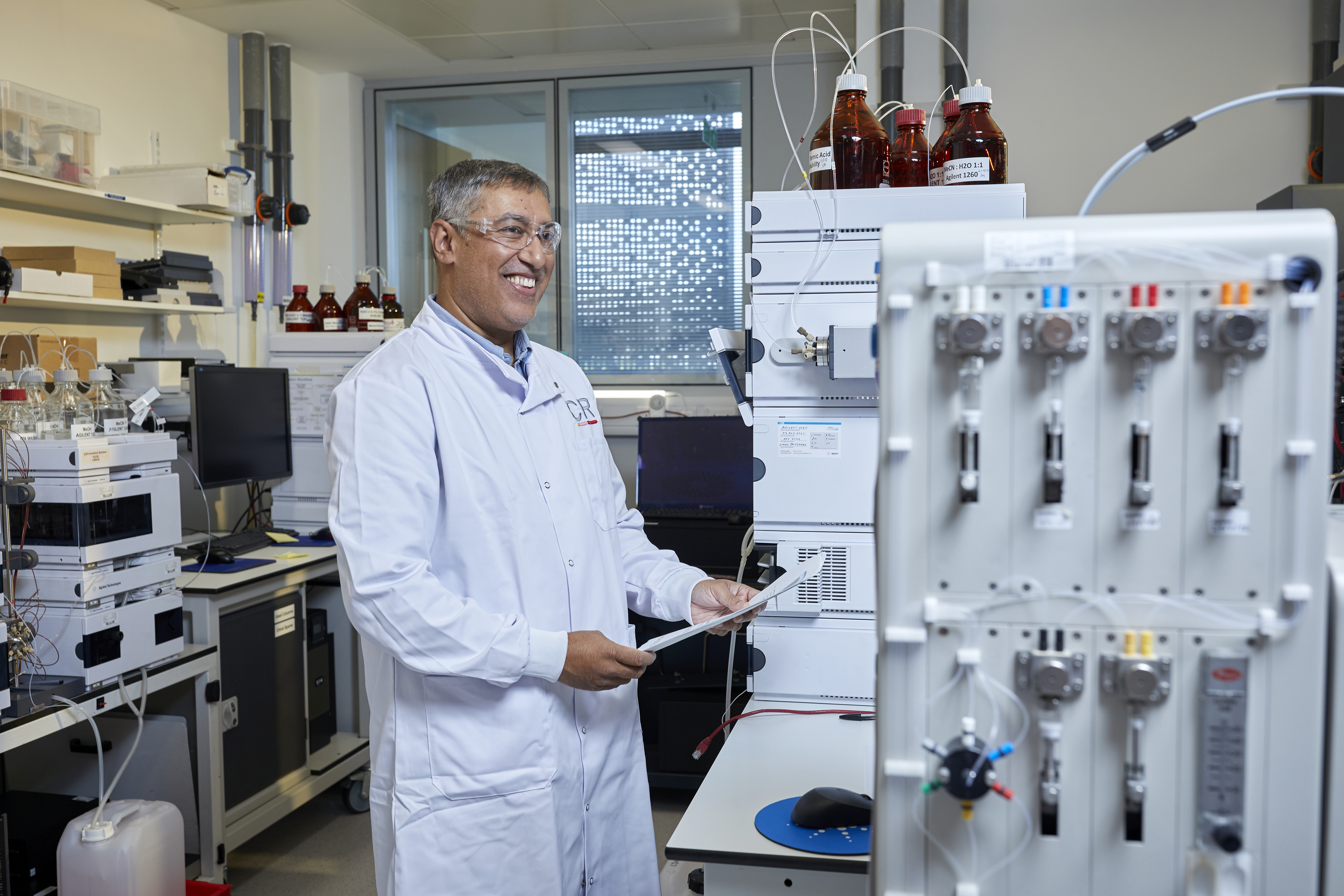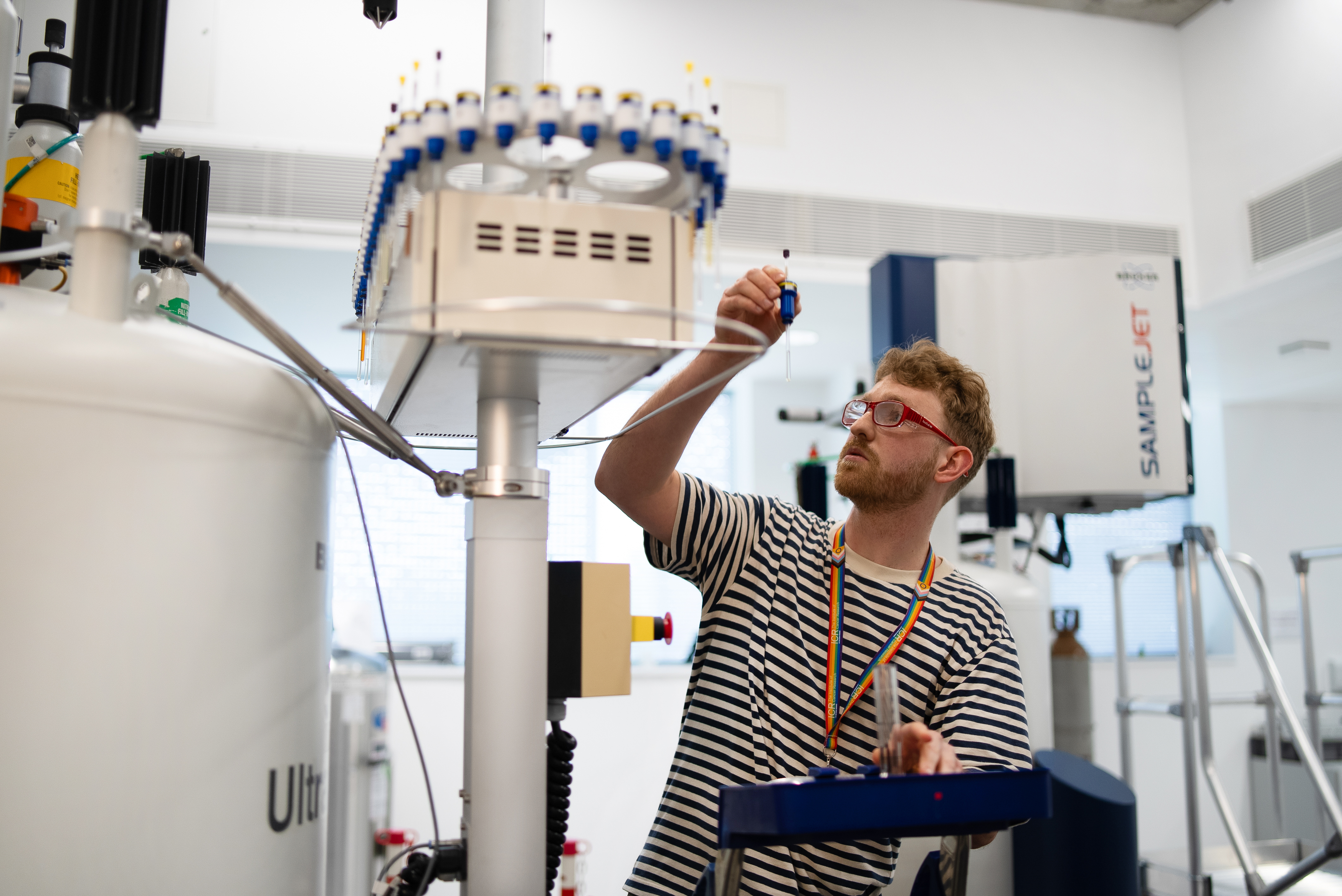In the Centre for Cancer Drug Discovery at The Institute of Cancer Research, London, high-precision technologies are transforming how we uncover the intricate details of molecules and accelerate the development of new cancer treatments. From weighing molecules with extraordinary precision to visualising their atomic structure, Robbie Lockyer visited the lab to understand how these tools are accelerating the journey from lab bench to hospital bedside.
The process of discovering new cancer drugs is incredibly complex, requiring scientists to design, test and refine thousands of chemical compounds. Each potential drug must be carefully analysed to confirm its identity, purity and effectiveness. This is where advanced analytical technologies come into play – providing research teams at The Institute of Cancer Research (ICR) with the data they need to make informed decisions and move promising compounds forward.
Among the most powerful tools in this process are mass spectrometry and nuclear magnetic resonance (NMR) housed in the Structural Chemistry Facility in the Centre for Cancer Drug Discovery. Together, they form the backbone of chemical analysis at the ICR, enabling researchers to characterise new compounds, understand how they interact with biological targets and identify those with the potential to become treatments.
In this blog post, we dive into how these technologies work, why they matter and how they’re being used at the ICR to meet our mission of making the discoveries that defeat cancer.
Weighing molecules with mass spectrometry
Mass spectrometry works by separating out the components of a mixture to allow researchers to weigh molecules with astonishing accuracy. Unlike your kitchen scales, mass spectrometry can detect the difference between a molecule with 10 atoms and one with 11.
Dr Amin Mirza, Head of the Structural Chemistry Facility who oversees mass spectrometry and NMR for the drug discovery programmes at the ICR, said: “When medicinal chemists create a new compound, they need to confirm it’s the right one that’s needed. Mass spectrometry helps by separating the components of a sample mixture – essentially, it’s different molecules – evaporating and charging them and spraying them in a fine mist through a flight tube – or a racetrack – inside the machine.
“At the end of the racetrack, an electron multiplier detects their arrival and calculates their weight based on how long they took to complete the race – where lighter molecules reach the finish line faster than heavier ones”.
The ICR has recently acquired a new mass spectrometer, funded by the Garfield Weston Foundation, and is one of the most advanced in the world. It uses turbomolecular pumps – to obtain and maintain a high vacuum – spinning at 20,000 revolutions per minute to create the perfect conditions for analysis.
Amin said: “This process helps our scientists identify the correct molecule and assess purity. It’s incredibly fast and flexible – capable of operating in multiple modes and run simultaneous experiments. It’s a very powerful tool for characterising compounds – on average, we analyse more than 50,000 sets of samples a year.
“Our medicinal chemists know what weight they’re aiming for. If the desired molecule is in the mixture, it’ll show up at that weight. But sometimes, molecules have the same atoms arranged differently – same weight, different structure – and mass spectrometry, no matter how high the resolution, can’t help with that. That’s where NMR comes in”.

Image: Dr Amin Mirza in the Structural Chemistry Facility
Seeing inside molecules with NMR
While mass spectrometry reveals molecular weight, NMR provides insight into molecular structure. NMR is incredibly versatile and works on similar principles to MRI scanners used in hospitals. Instead of scanning people, it scans chemical samples to map atomic connectivity.
The ICR houses three NMRs each cooled to near-absolute zero – around -269°C – using liquid helium and liquid nitrogen. These magnets create a mini ‘Earth-like’ magnetic field that aligns the atoms in a sample. An electromagnetic pulse is applied, disturbing them and causing them to shift. As they return to their original alignment, they emit signals or resonances that are captured and translated to reveal their connectivity and hence the structure of the molecule that the atoms are part of.
Each NMR machine has a transmitter coil that sends out a pulse and a receiver coil that listens for the response. The data is sent to a computer and is processed into a spectrum – a series of peaks that represent different atoms, their neighbours and molecular geometry. This detail allows researchers to distinguish between molecules that may have identical weights but different structures, and piece together molecular structures like a jigsaw.
These machines are highly sensitive – they can pick up electromagnetic noise from nearby construction or even air conditioning. To reduce background interference, one of the NMR machines uses a liquid helium-cooled ‘listening-coil’ probe, making it four times more sensitive than standard systems. This enables the detection of subtle structural differences that are critical in drug development.
Complementary technologies
Together, mass spectrometry and NMR provide a comprehensive toolkit for characterising new compounds. Mass spectrometry confirms molecular weight and purity, while NMR reveals how atoms are connected and arranged.
Amin said: “These technologies are particularly valuable in identifying molecules that bind to specific proteins – referred to as targets – in the body. In cancers, certain proteins can become overactive, problematic and contribute to disease progression. By designing molecules that fit into the protein’s active site, we can disrupt its function and potentially halt the spread of that cancer.”
When a molecule binds to a protein – or sticks into a protein’s active ‘pocket’ – its overall mass changes. Mass spectrometry can detect this change to indicate a successful interaction or ‘hit’ within a screening assay. Chemists can then refine the molecule to improve its binding strength and duration, increasing its potential as a therapeutic target.
A notable example is the drug capivasertib – used for treating the most common type of advanced breast cancer – which targets the protein AKT and was discovered by AstraZeneca subsequent to a collaboration with Astex Pharmaceuticals (and its collaboration with the ICR and Cancer Research Technology Limited). Every potential drug discovered at the ICR, from early ‘hits’ to ones that enter clinical trials, has undergone characterisation by the Structural Chemistry team using mass spectrometry and NMR, underscoring the importance of these technologies in the drug discovery pipeline.
Amin said: “I’ve been very fortunate in that during the 26 years I have been at the ICR, every drug that’s gone into the clinic has passed through our hands.”

Image: 3D-printed model of the targeted PARP-inhibitor drug Olaparib.
Innovation by customisation
The ICR is known for its innovative approach to technology, often modifying commercial instruments to meet specific research needs. The new mass spectrometry screening platform, funded by Garfield Weston, is a prime example. Once fully operational it will be the only system of its kind in the world.
The platform is based on a concept developed by Professor Ron Quinn in Brisbane, who pioneered a new method of mass spectrometry-based screening. A member of the ICR team, Beth Jago, Higher Scientific Officer in Medicinal Chemistry, received funding from the Knowledge Exchange Placement run by the United Kingdom Institute for Technical Skills and Strategy to train with Professor Quinn and bring the expertise back to London. The technique has already been tested as proof of concept on an old mass spectrometer and will be fully implemented onto the new platform.
Amin said: “Unlike traditional academic setups that often build prototype instruments from scratch, the ICR adapts commercial systems to create highly specialised tools. This approach allows us to push the boundaries of what’s possible while maintaining reliability and scalability and hopefully inspire others to follow suit.”
Accelerating innovation and impact
With a compound library of more than 200,000 molecules at the ICR, the ability to screen efficiently is essential. Mass spectrometry and NMR enable researchers to test small or large mixtures, depending on the experimental design. Computational chemists help concoct mixtures that don’t interfere with each other in the assay, to maximise the chance of identifying promising ‘hits’.
These technologies not only accelerate the pace of discovery but also improve the accuracy and reproducibility of results. By providing detailed insights into molecular identity and interaction, they help researchers make informed decisions and prioritise compounds for further development.
Amin said: “The continued advancement of drug discovery at the ICR is made possible by the generosity of donors and funders. Technologies such as mass spectrometry and NMR are vital tools in our wheelhouse in the fight against cancer, and their presence in our labs reflects the commitment of those who believe in our mission.”
Every drug discovery project at the ICR has, at some stage, relied on the expertise of the Structural Chemistry team and the technologies they use. With ongoing support, the Centre for Cancer Drug Discovery will remain at the forefront of innovation – developing new treatments and bringing hope to people affected by cancer.
